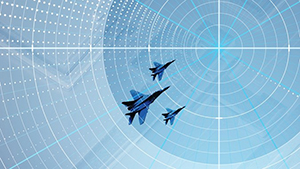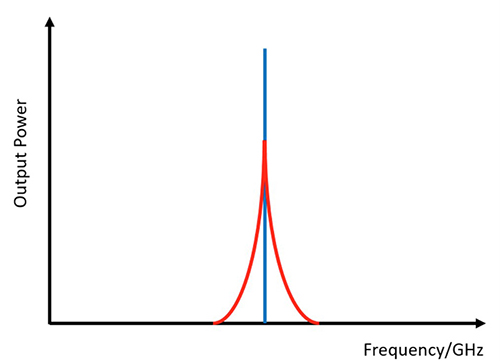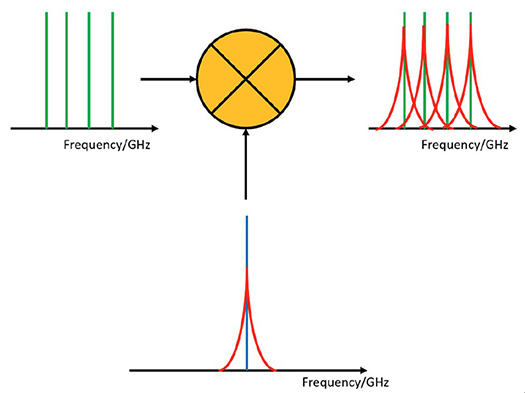Addressing Phase Noise Challenges in Radar and Communication Systems: Part 1
July 9, 2019
This blog post was first published by Custom MMIC who joined the Qorvo family in February 2020. Custom MMIC is known for its best-in-class die and packaged components, which augment our power amplifiers to enable multi-chip modules for a broad range of defense, aerospace and commercial applications.
Introduction
 Phase noise is rapidly becoming the most critical factor addressed in sophisticated radar and communication systems. This is because it is the key parameter defining target acquisition in radars and spectral integrity in communication systems. There are many papers detailing the mathematical derivation of phase noise, but few mention the reasons for its importance. In part 1 of this two-part blog series, we'll discuss the generalities of phase noise and how it can affect the performance of different microwave systems.
Phase noise is rapidly becoming the most critical factor addressed in sophisticated radar and communication systems. This is because it is the key parameter defining target acquisition in radars and spectral integrity in communication systems. There are many papers detailing the mathematical derivation of phase noise, but few mention the reasons for its importance. In part 1 of this two-part blog series, we'll discuss the generalities of phase noise and how it can affect the performance of different microwave systems.
What is Phase Noise?
Phase noise is commonly used as a measure of frequency stability within an oscillator. This noise is inherently different than the general background noise of any electrical system, which is defined as kTB, where k is Boltzmann’s constant, B is the bandwidth, and T is the temperature. Instead, phase noise is a secondary effect directly related to the topology and construction of the oscillator.
 Figure 1: Ideal signal (blue) and a signal with phase noise (red).
Figure 1: Ideal signal (blue) and a signal with phase noise (red).
Why do we care about Phase Noise?
Phase noise can affect the performance of many different microwave systems. In part 1 of this blog series we'll discuss two in particular: direct downconversion receivers, and radars.
Direct downconversion is a type of receiver in microwave communication systems. One benefit of direct downconversion is the simplicity of the circuit, which is essentially a single mixer driven by a local oscillator (LO) to convert the input RF signal to a baseband (very low frequency). This baseband signal is then directly applied to an analog-to-digital converter for processing. A common term for this architecture is “RF in, bits out”. One problem with direct downconversion though, is that the input RF signal can be very close in frequency to the LO, which makes the conversion process susceptible to phase noise - especially if the signal strength is low.
In radar systems, the problem is similar in nature. Radar systems operate by transmitting a pulse at one frequency and then measuring the frequency shift of the returned pulse, as the shift is related to the velocity of the object being imaged through the Doppler effect. Objects moving very slowly will generate a return pulse very close in frequency to the transmitted pulse, and if the cross section of the object is also very small, the power level of this received signal will be also very low. Ultimately this return pulse has to be converted to baseband in order to recover the velocity information, and phase noise can obscure the data.
In Figure 2, we can see that if the power level of the RF signal we wish to convert falls below the phase noise spectrum of the LO signal, we will be unable to recover any baseband information, as the signal will be in the noise. Therefore, reducing the phase noise will increase our receiver sensitivity.
 Figure 2: Ideal LO signal (blue), an LO signal with phase noise (red), and an RF signal close in frequency (green) we wish to convert to baseband.
Figure 2: Ideal LO signal (blue), an LO signal with phase noise (red), and an RF signal close in frequency (green) we wish to convert to baseband.
In Figure 3, we present how phase noise can negatively impact a conversion, this time of a multi-carrier orthogonal frequency-division multiplexed (OFDM) signal. In this figure, we note that if the phase noise of the LO is too high, then the noise will be converted into adjacent channels of the baseband data, thereby ruining the integrity of the information.
 Figure 3: Phase noise issues in OFDM systems. Ideal LO signal (blue), LO signal with phase noise (red), RF signal (green).
Figure 3: Phase noise issues in OFDM systems. Ideal LO signal (blue), LO signal with phase noise (red), RF signal (green).
Stay tuned for part 2 of this blog series where we'll discuss what can be done to lessen the effects of phase noise in your microwave systems using specific Custom MMIC solutions. To start solving your phase noise challenges immediately contact us today.
Have another topic that you would like Qorvo experts to cover? Email your suggestions to the Qorvo Blog team and it could be featured in an upcoming post. Please include your contact information in the body of the email.